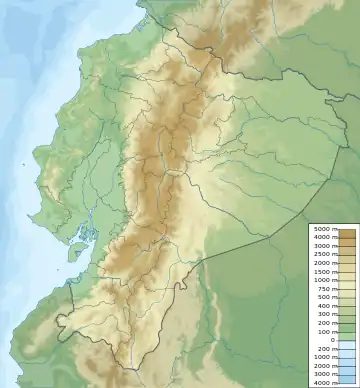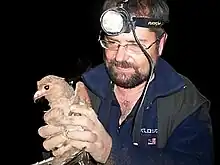Cueva de los Tayos
Cueva de los Tayos (Spanish, "Cave of the Oilbirds") is a cave located on the eastern slopes of the Andes mountains in the Morona-Santiago province of Ecuador and shot into fame after astronaut Neil Armstrong visited it during 1976. It is sometimes called Cueva de los Tayos de Coangos (the Río Coangos is nearby).
| Cueva de los Tayos | |
|---|---|
| Cueva de los Tayos de Coangos | |
 Cueva de los Tayos | |
 | |
| Location | Morona-Santiago Province |
| Coordinates | 3°03′07.5″S 78°12′19.3″W |
| Length | 4.6 km (2.9 mi) |
| Elevation | 539 m (1,768 ft) |
| Discovery | Precolumbian era |
| Geology | Limestone & shale |
| Access | Restricted |
| Translation | Cave of the Oilbirds (Spanish) |
Description
Cueva de los Tayos is located in the high rainforest, 2 kilometres (1.2 mi) south of the Santiago River, and 800 metres (2,600 ft) west of Coangos River. The entrance to the cave has a vertical void of 70 meters and local people were aware of this cave for centuries.[1] According to a GPS measurement in 2008, its altitude is 539 metres (1,768 ft) above sea level. Located at an elevation of about 800 metres (2,600 ft) within thinly-bedded limestone and shale, the principal entrance to Cueva de Los Tayos is within a rainforest at the bottom of a dry valley. The largest of three entrances is a 65 metres (213 ft) deep shaft leading to 4.6 kilometres (2.9 mi)[2] of spacious passages and a chamber measuring 90 by 240 metres (300 by 790 ft). The cave has a vertical range of 201 metres (659 ft) with its lowest point ending in a sump. It is currently (2023) the longest cave in Ecuador.
The cave is used by the native Shuar people who descend into the cave each spring using vine ladders and bamboo torches to collect fledgling oilbirds ("guácharos" or "tayos" in Spanish). Written references to the cave go back as far as 1860 and it was visited by gold-seekers and military personnel in the 1960s.
The cave is located inside the Sindical Center Coangos (formed by native people). The caves are not fully explored yet and local Shuar Indians have in-depth knowledge of the cave and they act as guides for cave explorers.[1]
Access to the cave is restricted. It is necessary to obtain permission (access and temporary visit) and pay a tax (designated to improve the communities) in Sucúa, Ecuador, at the Shuar Center Federation. (FICSH: Federación Interprovincial de Centros Shuar)
The Gold of the Gods
A 1969 expedition to the cave is described in Pino Turolla’s 1970 book Beyond the Andes. Erich von Däniken wrote in his 1973 book The Gold of the Gods that János Juan Móricz (1923–1991) had claimed to have explored Cueva de los Tayos in 1969 and discovered mounds of gold, unusual sculptures and a metallic library. These items were said to be in artificial tunnels that had been created by a lost civilization with help from extraterrestrial beings. Von Däniken had previously claimed in his 1968 book, Chariots of the Gods?, that extraterrestrials were involved in ancient civilizations. It is rumored strongly that the cave contains relics of a lost civilization. [3]
1976 BCRA expedition
As a result of the claims published in von Däniken’s book, an investigation of Cueva de los Tayos was organized by Stan Hall of Scotland, in 1976. One of the largest and most expensive cave explorations ever undertaken, the expedition involved over a hundred people, including experts in a variety of fields, British and Ecuadorian military personnel, a film crew, and former American astronaut Neil Armstrong.[4][5] The team also included eight experienced British cavers who thoroughly explored the cave and conducted an accurate survey to produce a detailed map of it. This expedition was financed by Government of Ecuador and United Kingdom.[1] There was no evidence of Von Däniken’s more exotic claims, although some physical features of the cave did approximate his descriptions and some items of zoological, botanical, and archaeological interest were found. The team found passageways cut neatly and polished deep inside the cave and also burial sites dating back to 1500 BCE[3] The lead researcher met with Moricz's indigenous source, who claimed that they had investigated the wrong cave, and that the real cave was secret.[6] Deep inside the cave, there are square shaped rock cuttings and rock structures resembling elongated doors and that portion is called Moricz portal. [1]
2006-2009 Expeditions

As a friend and disciple of the main protagonists and discoverers of the caves (1960s), the Argentinian explorer and filmmaker Alex Chionetti carried out a series of expeditions between 2006 and 2009. In 2007 he reached the depths of the main cave (the Coangos River Cave) after several months of back and forth through the jungle and hostilities from the local indigenous people.[7]
Chionetti discovered figures of animals along the underground rivers in the system of the Pastaza Tayos caves, as well as an engraving on a gold patina representing a double quadrilateral. Also in Coangos, he was the first to digitally record the now called Moricz's Entrance Gate (previously Von Daniken's), thus highlighting what is called "the cornerstone", an architectural detail that would prove that parts of the structure have been built or adapted to the landscape or natural setting of the caves.
The Argentinian born explorer put the place on the map (2010) when acting as consulting producer for the series 'Ancient Aliens' (History Channel, Promoeteous Entertainment).
In his bestseller book "Mysteries of the Tayos Caves", Chionetti recounts his harrowing exploration and survival odyssey when a Shuar native party decided to attack his group after leaving the caves. The American press covered the story as frontpage describing Chionetti as a real Indiana Jones, struggling through the amazon jungle and chased as the legendary movie explorer.
2018 Expedition Unknown episode
On 31 January 2018, Tayos Cave was featured on the 6th episode of the 4th season of Expedition Unknown, titled "Hunt for the Metal Library". Explorer Josh Gates and his team, helped by local Shuar and Eileen Hall, daughter of Stan Hall of the earlier expedition, headed to Ecuador to explore the depths of the cavern.[8]
References
- Brooks, Dairo (27 November 2017). "The Cueva de los Tayos, the legendary and mysterious formation of Ecuador that aroused the fascination of astronaut Neil Armstrong". BBC. bbc.com. Retrieved 21 April 2023.
- Judson, David (Nov 1976). "Los Tayos Expedition, Ecuador : July-August 1976". British Cave Research Association (BCRA). 14: 26–30.
- Kushner, David (20 December 2020). "Journey to the centre of the earth". Outside online magazine. Outside online. Retrieved 21 April 2023.
- Judson, David (Nov 1976). "Los Tayos Expedition, Ecuador : July-August 1976". British Cave Research Association (BCRA). 14: 26–30.
- Colavito, Jason. "Remembering Neil Armstrong's Brush with Ancient Astronauts". JASON COLAVITO. Retrieved 2 May 2022.
- Hall, Stan (2015) [2005]. Tayos Gold: The Archives of Atlantis. "Body, Mind & Spirit" series. Adventures Unlimited Press. notably chapter 20. ISBN 978-1931882675 – via Google Books.
- Asbury Park Press, New Jersey (April 21, 2007). "Red Bank writer-explorer has a tale to tell on film".
- James Wray (31 January 2018). "Josh Gates investigates Tayos Cave and the Metal Library on Expedition Unknown". monstersandcritics.com.
Further reading
- Frankland, John, "The Los Tayos Expedition" Caving International No 1, 1978
- Atlas – Great Caves of the World Cave Books, 1989, p. 58 ISBN 0-939748-21-5
- von Däniken, Erich, Gold of the Gods Bantam Books, 1974 ISBN 0-553-10968-5
- Chionetti, Alex, Mysteries of the Tayos Caves: The Lost Civilizations Where the Andes Meet the Amazon (2019) ISBN 9781591433569.